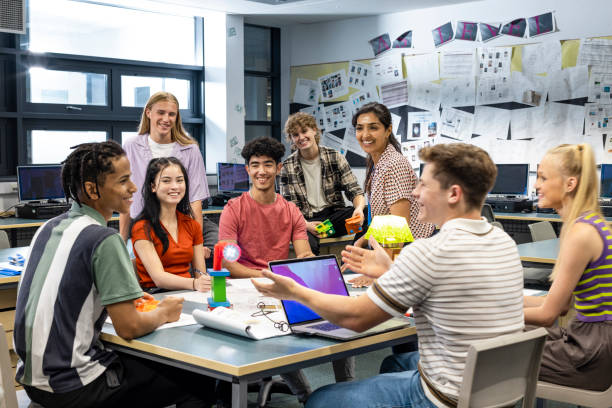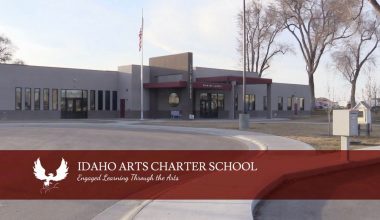When you think of high school, what comes to mind? Traditional classrooms, strict schedules, and standardized tests? What if there was a different way to approach high school education?
Non-traditional high schools are becoming more popular as educators and parents seek alternative options for students who may not thrive in a traditional school setting. These schools offer unique learning environments, flexible schedules, and hands-on experiences that cater to the individual needs of each student.
If you are looking for a high school experience that is outside of the box, a non-traditional high school may be the perfect fit for you. In this article, we will explore the benefits of attending a non-traditional high school and how it can provide a more personalized and engaging education for students.
Table of contents
What are Non-Traditional High Schools?
Non-Traditional or Alternative high schools are simply schools that do not offer the full traditional learning experience. This is a very broad definition, so Non-Traditional high schools can vary greatly.
There are public or private schools, including magnet schools, charter schools, and online schools (although not all schools in these categories are considered Non-Traditional high schools).
Some Non-Traditional schools are offered through a student’s regular school district, while others are: Magnet, charter school, or private school that operates independently of the public school system.
Online school classes are conducted primarily or completely over the Internet. There is no formal designation as a “Non-Traditional school” or requirements that a school must meet to be considered a Non-Traditional school.
Non-Traditional high schools typically use the word “Non-Traditional” in their name or mention it in their philosophy or website homepage.
Non-Traditional schools were initially established to help “disabled” students who had behavioral problems and that traditional public schools had insufficient coping capacity.
Related Post: 20 Best Pre-Physical Therapy Studies Colleges 2024
What Are the Types of Non-Traditional High Schools?
Here are the different types of non-traditional high school. Let’s look at them.
Online High Schools
One type of non-traditional high school that has gained immense popularity in recent years is the online high school. Online learning provides students with the flexibility to study at their own pace and in their preferred setting.
This approach allows for individualized instruction and accommodates various learning styles. Students can access course materials and engage in interactive discussions through virtual platforms, granting them the freedom to manage their time efficiently and take ownership of their education.
However, online learning is not without its challenges. Students must possess self-discipline and strong time-management skills to stay organized and motivated in a virtual learning environment.
The absence of face-to-face interactions can also create a sense of isolation, making it crucial for online high schools to foster virtual communities and provide adequate support networks.
Charter Schools
Charter schools represent another form of non-traditional high school that offer unique features. These schools operate independently, often with a specific educational philosophy or focus.
Charter schools have more autonomy compared to traditional public schools, allowing them to innovate and tailor their curriculum to meet the needs of their student population. This freedom enables the implementation of alternative teaching methods and specialized programs.
While charter schools provide flexibility and choice, they must also maintain accountability. They are typically held to performance standards outlined in their charter agreements, ensuring that students receive a quality education.
This balance between autonomy and accountability encourages continuous improvement and innovation within the charter school system.
Magnet Schools
Magnet schools are non-traditional high schools that specialize in specific areas of study, such as STEM (Science, Technology, Engineering, and Mathematics), arts, or vocational training. These schools offer a focused and specialized curriculum to students who have a keen interest in particular subjects.
By concentrating on specific disciplines, magnet schools provide students with in-depth knowledge and practical skills that can prepare them for future careers or higher education in their chosen fields.
Admission to magnet schools often involves a competitive process, with students required to demonstrate aptitude and passion for the respective areas of focus.
The benefits of attending a magnet school include exposure to specialized resources, opportunities for internships, and access to industry professionals who can serve as mentors.
Homeschooling
Homeschooling has gained traction as a non-traditional approach to high school education, offering students the opportunity for individualized and flexible learning. Homeschoolers typically follow a customized curriculum based on their interests, strengths, and learning styles.
This approach allows students to explore topics in greater depth, adjust the pace of learning, and engage in experiential and hands-on activities.
One of the advantages of homeschooling is the ability to create a supportive learning environment tailored to the student’s unique needs.
Homeschooling communities provide resources, co-op classes, and social opportunities, enabling students to interact with peers and participate in group activities.
Additionally, homeschooling allows for a more flexible schedule, accommodating students who pursue extracurricular passions or have specific circumstances that require personalized attention.
Related Post: University of California-Berkeley College Majors Data
What are the Characteristics of Non-Traditional High Schools?
Non-traditional high schools exhibit distinctive features that set them apart from traditional educational settings. These features contribute to a unique learning experience that caters to individual student needs. Some key features of non-traditional high schools include:
Personalized Learning
One of the defining characteristics of non-traditional high schools is their emphasis on personalized learning. These schools recognize that each student has unique strengths, weaknesses, and learning preferences.
By tailoring the curriculum and instruction to individual needs, non-traditional high schools promote a more effective and engaging learning experience.
Personalized learning involves creating customized learning plans for each student, allowing them to progress at their own pace and focus on areas of interest.
Individualized support and attention from educators ensure that students receive the guidance they need to succeed academically and personally.
Flexible Schedules and Settings
Non-traditional high schools often provide flexibility in terms of schedules and settings. Blended learning approaches, combining online and in-person instruction, offer students the opportunity to engage in both independent study and collaborative learning experiences.
This flexibility accommodates students with diverse commitments and allows them to balance academic pursuits with other responsibilities or interests.
Additionally, non-traditional high schools explore off-campus learning opportunities. Students may have the chance to participate in internships, community service projects, or apprenticeships, providing real-world experiences that complement their academic studies.
Such experiences foster critical thinking, problem-solving, and practical skills development.
Emphasis on Practical Skills
Another distinguishing feature of non-traditional high schools is their focus on practical skills. Recognizing the importance of preparing students for future careers, these schools often integrate vocational training programs into their curricula.
By offering hands-on experiences and industry-specific coursework, non-traditional high schools equip students with valuable skills that are directly applicable to the workforce.
Practical skills education can include technical training, entrepreneurship programs, or project-based learning initiatives.
By engaging students in real-world applications of their knowledge, non-traditional high schools empower them to become competent and confident individuals ready to navigate the challenges of the professional world.
Non-Traditional Teaching Methods
Non-traditional high schools often employ innovative and Non-Traditional teaching methods. These may include project-based learning, experiential learning, flipped classrooms, or interdisciplinary approaches.
By embracing diverse teaching strategies, non-traditional high schools aim to create engaging and interactive learning experiences that foster critical thinking, creativity, and problem-solving skills.
Related Post: 25 Best Pharmaceutical Sciences Colleges in 2024
What Are the Benefits of Non-Traditional High Schools?
Attending a non-traditional high school offers several potential benefits to students. It is important to consider these advantages when deciding whether this educational path is the right fit:
Individualized Attention
Non-traditional high schools typically have smaller class sizes, allowing for more individualized attention from teachers. This personalized approach enables educators to address students’ specific learning needs, provide timely feedback, and offer tailored support, resulting in enhanced academic growth and student success.
Flexibility and Customization
These schools offer students greater flexibility in terms of scheduling and curriculum customization. This flexibility allows students to pursue their passions, explore interdisciplinary subjects, engage in real-world experiences, or dedicate time to personal interests alongside their academic pursuits.
Focus on Specialized Fields or Interests
Some non-traditional high schools specialize in particular fields or interests, such as STEM, arts, or vocational training.
Attending such schools provides students with an opportunity to delve deeply into their areas of interest, receive specialized instruction, and develop advanced skills that can give them a competitive edge in their future careers or higher education endeavors.
Enhanced Student Engagement
Non-traditional high schools prioritize student engagement through active learning strategies and a student-centered approach. These schools understand that active involvement in the learning process leads to better comprehension, retention, and application of knowledge.
By incorporating hands-on activities, discussions, and collaborative projects, non-traditional high schools foster a dynamic and stimulating learning environment.
Furthermore, the emphasis on personalized learning ensures that students feel valued and supported. Educators take into account students’ interests, aspirations, and learning styles, fostering a sense of ownership and motivation.
This approach enhances student engagement and promotes a genuine passion for learning.
Higher Graduation Rates
Non-traditional high schools have been associated with higher graduation rates compared to their traditional counterparts. The personalized support and mentorship available in these schools play a significant role in keeping students on track to complete their education.
Educators work closely with students to identify any academic challenges, provide additional resources or tutoring when needed, and create customized learning plans that align with students’ goals.
Moreover, non-traditional high schools offer flexible pathways to graduation. Students who may have struggled in traditional settings find Non-Traditional approaches that better suit their needs, leading to increased success rates and improved overall graduation rates.
Related Post: What Are the Pros and Cons of Using 529 Plans? What it is & How it Works
What Are Some of the Challenges of Non-Traditional High Schools?
While non-traditional high schools offer numerous advantages, it is important to consider the potential drawbacks before making a decision:
One of the challenges often associated with non-traditional high schools is the potential lack of social interaction. Online high schools, for instance, may limit face-to-face interactions with peers and educators.
To mitigate this issue, non-traditional high schools must create virtual communities and opportunities for students to connect and collaborate.
Discussion boards, online group projects, and virtual clubs can help foster a sense of belonging and encourage social interaction.
Furthermore, community involvement opportunities play a crucial role in promoting socialization. Non-traditional high schools can encourage students to engage in extracurricular activities, volunteer work, or community service, enabling them to interact with a broader network of individuals and develop important social skills.
Limited Extracurricular Activities
Non-traditional high schools may offer limited extracurricular activities compared to traditional schools due to resource constraints or logistical challenges. However, it is essential for students to have opportunities for holistic development beyond academics.
Non-traditional high schools can address this challenge by exploring alternative options for extracurricular engagement. They can partner with local organizations, clubs, or sports teams to offer students a wider range of extracurricular activities.
Additionally, non-traditional high schools can encourage students to initiate their own clubs or pursue interests outside of the school setting, fostering a culture of self-directed exploration and growth.
Potential for Isolation
In some cases, non-traditional high school students may experience a sense of isolation due to the personalized nature of their education. This isolation can stem from a lack of daily interactions with peers or limited access to resources and counseling.
To combat potential isolation, non-traditional high schools must prioritize building support networks. This can include online forums or discussion boards where students can connect, share experiences, and seek advice.
Additionally, non-traditional high schools should ensure that students have access to counseling services, either through virtual means or by establishing partnerships with local mental health professionals, to address any emotional or psychological challenges that may arise.
Potential Lack of Traditional High School Experience
Attending a non-traditional high school means missing out on the traditional high school experience, including activities such as prom, pep rallies, and school sports teams.
For students who value these experiences or seek a more conventional educational journey, non-traditional high schools may not fulfill those expectations.
Related Post: Best Meteorology Colleges 2024
How Are Non-Traditional Different From Regular High Schools?
Non-traditional high schools differ from regular high schools in several key aspects:
Learning Environment: Non-traditional high schools often offer more flexible and personalized learning environments compared to regular high schools.
This can include online platforms, blended learning models, or project-based learning approaches. Regular high schools typically follow a more structured, teacher-centered instructional approach.
Curriculum Customization: Non-traditional high schools emphasize curriculum customization to meet individual student needs and interests. Regular high schools tend to have more standardized curricula, following state or district guidelines.
Class Size and Individual Attention: Non-traditional high schools often have smaller class sizes, allowing for more individual attention from teachers. Regular high schools tend to have larger class sizes, making personalized attention more challenging.
Teaching Methods: Non-traditional high schools may employ Non-Traditional teaching methods, such as experiential learning, flipped classrooms, or interdisciplinary approaches. Regular high schools generally adhere to more traditional teaching methods.
How to Choose the Right Non-Traditional High School
When selecting a non-traditional high school, it is crucial to consider the following factors:
Accreditation: Ensure that the non-traditional high school is accredited by a recognized accrediting agency. Accreditation ensures that the school meets certain quality standards and that credits earned will be transferable to other institutions if necessary.
Program Offerings: Evaluate the programs and courses offered by the non-traditional high school. Consider whether they align with the student’s interests, goals, and future aspirations. Look for schools that provide a comprehensive and robust curriculum.
Flexibility and Support: Assess the level of flexibility and support provided by the non-traditional high school. Consider factors such as the ability to customize the schedule, access to teachers and mentors, and availability of academic support services.
Success Stories and Alumni Network: Research the success stories of graduates from non-traditional high schools. Look for alumni who have achieved their academic and career goals and examine the college acceptance rates of the school’s graduates.
Consider whether the school has a strong alumni network that can provide support and connections in the future.
How Do Colleges View Non-Traditional High Schools?
Colleges and universities generally recognize non-traditional high schools as legitimate educational options. However, it is important to research the specific colleges and universities of interest to understand their admissions criteria and how they view non-traditional high school experiences.
Colleges typically evaluate applicants based on various factors, including academic performance, standardized test scores, extracurricular activities, and personal achievements.
Non-traditional high school applicants can showcase the unique aspects of their educational journey, emphasizing the skills, experiences, and achievements gained through their non-traditional education.
It is advisable to contact the admissions offices of prospective colleges to inquire about their policies regarding non-traditional high school applications.
Seeking guidance from college counselors or educational consultants can also provide valuable insights and assistance in navigating the college application process.
Related Post: 12 Best Industrial And Product Design Colleges 2024
Frequently Asked Questions
Traditional students are often defined as students who have entered college after high school and non-traditional students are commonly agreed to be those who have returned to school sometime after.
a setting where a teacher communicates with a group of students in a typical brick-and-mortar classroom set-up.
Education that is offered in ways other than common daytime college classrooms.
Conclusion
Non-traditional schools emphasize personalized learning, flexible schedules, practical skills development, and enhanced student engagement.
Understanding the features, advantages, and disadvantages of non-traditional high schools is crucial when considering this educational option.
By weighing the pros and cons, exploring how non-traditional high schools differ from regular high schools, and researching college perspectives, individuals can make informed decisions about whether a non-traditional high school is the right choice for their educational journey.
Non-traditional high schools have yielded success stories, showcasing how these innovative educational models can prepare students for future careers and higher education.
References
- collegeraptor.com-alternative non-traditional high school
- apply.spps.org-alternative learning programs
- dailymom.com-non traditional alternatives for high school
- blog.prepscholar.com-alternative high schools




